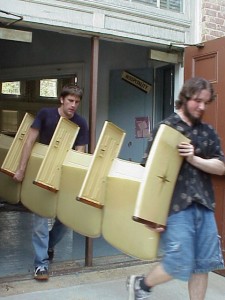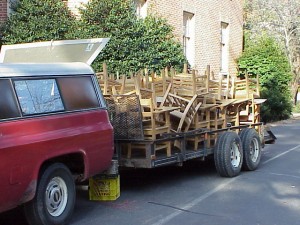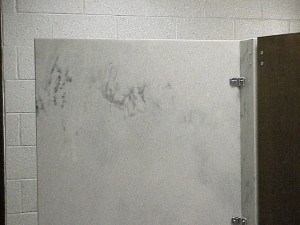Design Requirements
This information supports and supplements information included in the UNC-Chapel Hill Design Guidelines—specifically, Chapter II: Construction Documents Submittal requirements, Chapter III: Construction and Demolition Waste Management and Chapter V: Sections 01606, 01505, and 02070.
General
This section refers to the building components such as slate roofing, brick pavers, stone, marble bathroom partitions, doors, windows, architectural elements.
Hierarchy
- Reuse in project
- Reuse on campus
- Recycle (grinding wood for mulch, metal shelves sent to scrap yard)
- Disposal (in accordance with state regulations)
Building Material Walkthrough and Inventory of Valuable & Reusable Materials
- To identify existing materials that can be reused in the project, the designer (with UNC Design Manager, OWRR and customer) perform an initial walkthrough of the building in the schematic design phase.
- The project creates an initial inventory of valuable and reusable materials.
- They evaluate the reuse of these materials back into the project.
- The inventory of materials to be reused in the project, salvaged for use in other projects, or to be recycled is to be included in Section 01505.
Reuse in Project
For materials to be reused in the project, the Designer will create a detailed plan for removal, refurbishment, storage, and reinstallation of said materials to be included in Section 02070.
Reuse in Other Projects
 Information about any valuable materials not being reused (i.e. slate roofing) should be shared with other UNC Planning Managers and Building Services Supervisors. For materials to be reused in other projects on campus, the UNC Planning Managers or Building Services Supervisors will work together to create a salvage plan.
Information about any valuable materials not being reused (i.e. slate roofing) should be shared with other UNC Planning Managers and Building Services Supervisors. For materials to be reused in other projects on campus, the UNC Planning Managers or Building Services Supervisors will work together to create a salvage plan.
Recycle and Off-Campus Salvage
The designers should use the inventory of remaining materials in coordination with OWRR to create a list of project-specific materials required and suggested to be recycled to assist the Contractor in the creation of a Solid Waste Management Plan. This list should be developed in coordination with OWRR and included in Section 01505, Section C, Draft Solid Waste Management Plan.
Disposal
Disposal is in accordance with state and local regulations. See Section 01060 for more information.
The information in this section can be found in the UNC Design Guidelines, Chapter III. University Planning Standards, Section E. Waste Management, b) Design Requirements, 1) Building Material Assessment and Salvage.
General
This refers to bulletin boards, clocks, pencil sharpeners, desks, chairs, lab equipment, kitchen equipment, audio visual equipment, capital assets, etc.
Making sure that everything in the building is removed from the building and relocated or properly disposed of is very important. For this to happen smoothly and efficiently, communication and coordination between the Designer, the owning department, the move coordinator, the UNC design and construction managers, Surplus Property, the movers, and OWRR is required.
Hierarchy
- Reuse by department
- Reuse on campus
- Sell through Surplus (on-site if appropriate)
- Disposal in accordance with state regulations
Building Material Walkthrough and Inventory of Valuable & Reusable Materials
The Designer (with the help of UNC Design Manager) organizes a walkthrough of building with maintenance shops, Surplus, and OWRR during the Design Development phase to provide adequate time for prioritizing and planning salvage.
The purpose of this walkthrough is to evaluate a list of fixtures, furniture and equipment to be managed in accordance with the FF&E salvage hierarchy: reuse by the department, reuse on campus, sell through surplus (on-site, if appropriate) and disposal in accordance with state regulations.
Salvage List
A list is generated detailing items to be salvaged and who will be responsible for removing, transporting, and storing said items. This list is to be distributed to the UNC Planning Manager, shops, Surplus, OWRR, and department representatives.
Surplus Property
An inventory of any movable furniture and equipment not being reused needs to be provided to Surplus. Options for handling excess furniture may include:
- transfer to other departments (Business Managers may be contacted and notified of available equipment)
- sell onsite using a Surplus framework, or
- transport to the UNC Surplus Warehouse to be sold
Departmental Responsibilities
It is the owning department’s responsible to make sure that the proper asset management and surplus property forms have been completed. The owning department must also arrange for the transportation of any surplus movable furniture and equipment to the surplus warehouse. For more guidance, please refer to the UNC-Chapel Hill Design Guidelines Chapter IV: Moving Procedures for Bond Projects.
Shop Follow Up
The shops will report back to the UNC Planning Manager and OWRR when they have completed their salvage. This work will take place before the Contractor takes possession of the building, if possible. Any other arrangement must be detailed on the plans.
Cost Estimate
The Designer will also, as part of their cost estimate, break out the cost and any benefit of any salvage and reuse compared to purchasing new building materials or fixtures, furniture and equipment. This will be used to prioritize salvage and recycling options, and should be completed during the Design Development phase.
Scheduling
 Time for salvage and moving furniture must be considered when creating the project schedule. It is important to think about the appropriate condition of a building at the time of transfer to the Contractor. Asbestos abatement often requires that all furniture and trash be removed prior to beginning work.
Time for salvage and moving furniture must be considered when creating the project schedule. It is important to think about the appropriate condition of a building at the time of transfer to the Contractor. Asbestos abatement often requires that all furniture and trash be removed prior to beginning work.
Construction Documents
Any salvage involving the Contractor is to be clearly designated on the Construction Document set of plans.
As appropriate, any equipment or fixtures of interest that will be left as part of the project should be included in Section 01505 to assist the contractor with the preparation of a solid waste management plan. They may be included in the project specific salvage and recycling requirements or in the list optional materials for which salvage and recycling options are to be evaluated by the contractor.
All movable furniture and equipment should be removed prior to the contractor taking possession of the building.
The information in this section can be found in the UNC Design Guidelines, Chapter III. University Planning Standards, Section E. Waste Management, b) Design Requirements, 2) Fixtures, Furniture, and Equipment Salvage.

